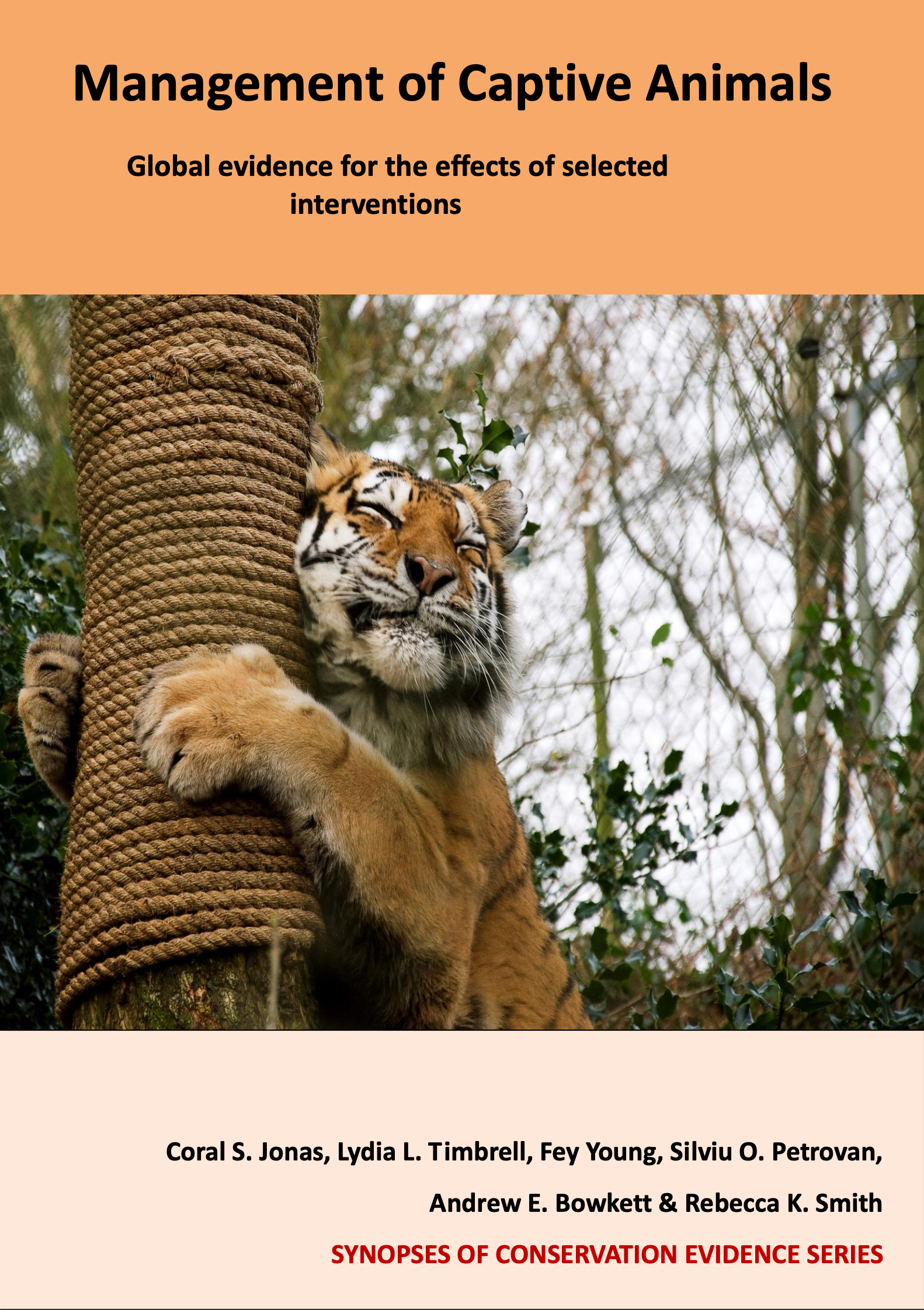Actions to conserve biodiversity
We have summarised evidence from the scientific literature about the effects of actions to conserve wildlife and ecosystems.
Review the evidence from the studies
Not sure what Actions are? Read a brief description.
Search for evidence
e.g. "frogs chytrid"
96 Actions found
Refine
Hide
96 Actions found
Download Actions
| 0 selected |
|
Order results by:
| Action | Effectiveness | Studies | Category | |
|---|---|---|---|---|
|
Primates: Use of automated feeders Action Link |
No evidence found (no assessment) | 0 |
|
|
|
Primates: Feed individuals separately Action Link |
No evidence found (no assessment) | 0 |
|
|
|
Primates: Feed individuals in social groups Action Link |
Trade-off between benefit and harms | 2 |
|
|
|
Primates: Feed individuals in subgroups Action Link |
No evidence found (no assessment) | 0 |
|
|
|
Amphibians: Identify and breed a similar species to refine husbandry techniques prior to working with target species Action Link |
Unknown effectiveness (limited evidence) | 2 |
|
|
|
Amphibians: Vary enclosure humidity to simulate seasonal changes in the wild using humidifiers, foggers/misters or artificial rain Action Link |
No evidence found (no assessment) | 0 |
|
|
|
Amphibians: Vary enclosure temperature to simulate seasonal changes in the wild Action Link |
Unknown effectiveness (limited evidence) | 2 |
|
|
|
Amphibians: Vary quality or quantity (UV% or gradients) of enclosure lighting to simulate seasonal changes in the wild Action Link |
Unknown effectiveness (limited evidence) | 1 |
|
|
|
Amphibians: Vary duration of enclosure lighting to simulate seasonal changes in the wild Action Link |
No evidence found (no assessment) | 0 |
|
|
|
Amphibians: Simulate rainfall using sound recordings of rain and/or thunderstorms Action Link |
No evidence found (no assessment) | 0 |
|
|
|
Amphibians: Allow temperate amphibians to hibernate Action Link |
No evidence found (no assessment) | 0 |
|
|
|
Amphibians: Allow amphibians from highly seasonal environments to have a period of dormancy during a simulated drought period Action Link |
No evidence found (no assessment) | 0 |
|
|
|
Amphibians: Vary water flow/speed of artificial streams in enclosures for torrent breeding species Action Link |
No evidence found (no assessment) | 0 |
|
|
|
Amphibians: Provide artificial aquifers for species which breed in upwelling springs Action Link |
Unknown effectiveness (limited evidence) | 1 |
|
|
|
Amphibians: Vary artificial rainfall to simulate seasonal changes in the wild Action Link |
Unknown effectiveness (limited evidence) | 2 |
|
|
|
Amphibians: Provide multiple egg laying sites within an enclosure Action Link |
Unknown effectiveness (limited evidence) | 2 |
|
|
|
Amphibians: Provide natural substrate for species which do not breed in water (e.g. burrowing/tunnel breeders) Action Link |
Unknown effectiveness (limited evidence) | 2 |
|
|
|
Amphibians: Provide particular plants as breeding areas or egg laying sites Action Link |
Unknown effectiveness (limited evidence) | 1 |
|
|
|
Amphibians: Provide particular enclosure furniture for calling sites, breeding areas or egg laying sites Action Link |
Unknown effectiveness (limited evidence) | 2 |
|
|
|
Amphibians: Provide visual barriers for territorial species Action Link |
No evidence found (no assessment) | 0 |
|
|
|
Amphibians: Manipulate adult density within the enclosure Action Link |
No evidence found (no assessment) | 0 |
|
|
|
Amphibians: Manipulate sex ratio within the enclosure Action Link |
Unknown effectiveness (limited evidence) | 1 |
|
|
|
Amphibians: Separate sexes in non-breeding periods Action Link |
Unknown effectiveness (limited evidence) | 1 |
|
|
|
Amphibians: Play recordings of breeding calls to simulate breeding season in the wild Action Link |
Unknown effectiveness (limited evidence) | 2 |
|
|
|
Amphibians: Allow female mate choice Action Link |
Unknown effectiveness (limited evidence) | 2 |
|
Download Actions
| 0 selected |
|

Management of Captive Animals - Published 2018
Captive Animal Synopsis
Watch this search
If you are familiar with RSS feeds, please click the button below to retrieve the feed URL:
RSS feed for this searchIf you are unfamiliar with RSS feeds, we would suggest reading this BBC article.
Unfortunately, due to the number of feeds we have available, we cannot provide e-mail updates. However, you could use tools such as Feed My Inbox to do this for you.
What are 'Individual studies' and 'Actions'?
Individual studies
An individual study is a summary of a specific scientific study, usually taken from a scientific journal, but also from other resources such as reports. It tells you the background context, the action(s) taken and their consequences.
If you want more detail please look at the original reference.
Actions
Each action page focuses on a particular action you could take to benefit wildlife or ecosystems.
It contains brief (150-200 word) descriptions of relevant studies (context, action(s) taken and their consequences) and one or more key messages.
Key messages show the extent and main conclusions of the available evidence. Using links within key messages, you can look at the paragraphs describing each study to get more detail. Each paragraph allows you to assess the quality of the evidence and how relevant it is to your situation.
Where we found no evidence, we have been unable to assess whether or not an intervention is effective or has any harmful impacts.





)_2023.JPG)














